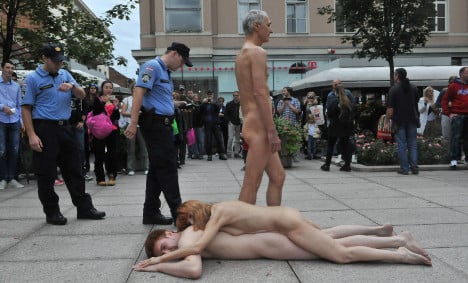The Body and Freedom festival, organized by Biel artist Thomas Zollinger, will see around 20 artists from all over the world stage naked performances in nine areas in Biel’s pedestrian zone, amid shoppers and passers-by.
Zollinger, who has staged one-off naked performances in Biel and other European cities for the past six years, told The Local that he wanted to break the taboo of the naked body in public.
“Every city today is interested in having festivals in public spaces – sculpture or performance or theatre – but in all work you see there, the naked body is like taboo.
“I want to make it normal to use the naked body in the public space for artistic reasons,” he said.
Zollinger, who is well known in the city after a 25-year career as an artist, admitted that the project is controversial and could be divisive.
“It’s a theme that affects everybody. Some like it, some have problems with it,” he told The Local.
“My experience is that most of passers-by find it ok, they are liberal and tolerant.”
“There are a lot of conservative people [in Switzerland],” he added, “but when you talk with Swiss people they are tolerant and they show openness.”
Local authorities, too, have been tolerant, allowing Zollinger to stage his festival and even part-funding the event – a change from his previous experiences staging naked art, such as a performance in Zagreb, which was interrupted by police.
“I had to fight for permission [in previous] years, but this year there’s really a good cooperation and I feel the support of the city,” he said.
Their main stipulation was that performances be limited to the city’s pedestrian streets, away from traffic.
“Authorities were afraid that there would be accidents and so on if drivers looked at the naked bodies!” he told The Local.

(Zollinger stages Naked Slow Walk in Zagreb. Photo: Tomislav Cuveljak)
Zollinger says he had no problem finding artists to take part in the festival.
“It’s like artists were waiting for an opportunity to perform naked in a public space.”
Among them, New York artist Miru Kim will sleep naked in a bed, a group of naked dancers will stage a Japanese dance, and Swiss artist Kaspar Bucher will invite members of the public to sit with him in a two-person naked sauna.
Zollinger is also calling for public participants to take part in a piece called Naked Audience, in which a group of naked people will stand on the pavement, looking at passers-by.
Many people have already signed up to participate, he told The Local.
“Most of them are men,” he said.
“Among the artists themselves there are half men, half women. In the case of women you have to motivate them [to participate]. But men volunteer themselves.”
British artist Glynis Ackermann, a long-time Swiss resident and frequent collaborator of Zollinger’s, will perform a piece called ‘Embracing Edges’, which aims to “soften the edges” of Biel’s architecture with the naked form, she told The Local.
“I think it’s very important to be able to see the naked body as a beautiful work of art, with what each one of us was born with,” she said.
Advance public information in the city will let people know about the festival “so they can avoid seeing a body if they want to,” she said.
“Biel is pretty used to this kind of thing because Thomas Zollinger has done quite a lot of naked projects here in Biel. And we have never had a bad experience whatsoever.”
“I think that if you have a certain level of presence then people are absolutely not going to think it’s going to be something weird or be afraid of approaching.
“As far as children go, they love it. They don’t even think anything about it, it’s nothing special at all, it’s only if their parents make a fuss that they begin to start studying what could be wrong.”
Watch a previous naked performance staged by Zollinger here (warning: contains nudity).



 Please whitelist us to continue reading.
Please whitelist us to continue reading.
Member comments